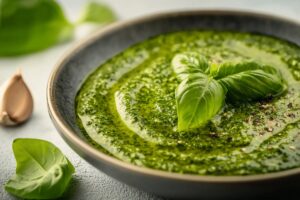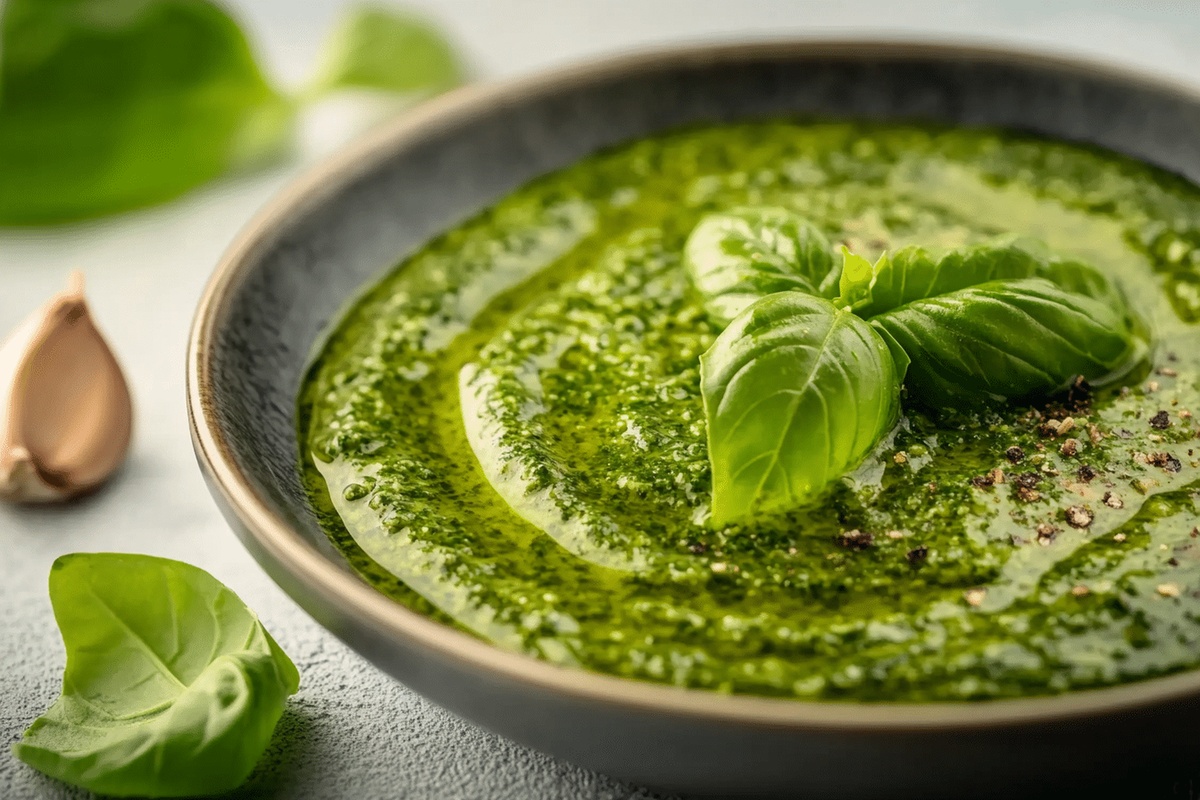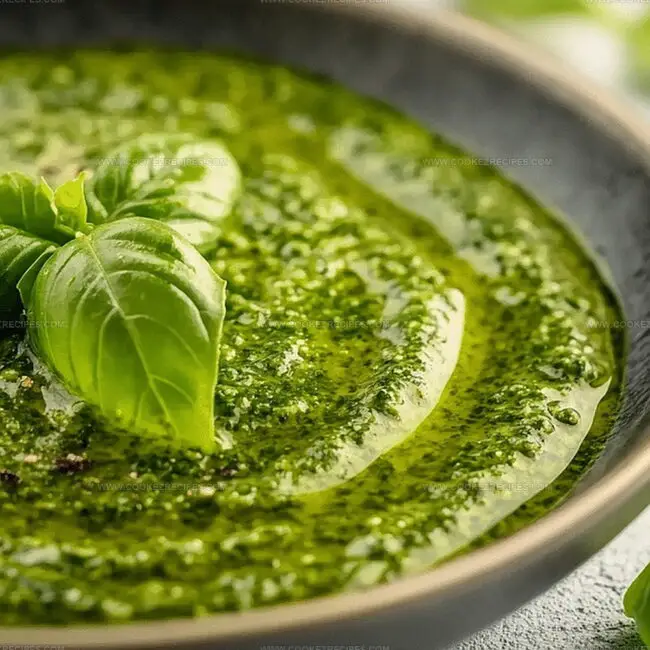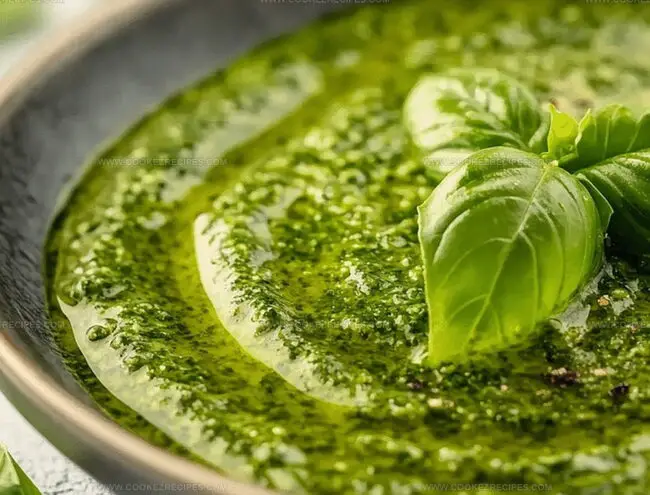Homemade Basil Pesto Recipe with Fresh Garden Ingredients
Whipping up a delectable basil pesto at home can transform your culinary adventures into something truly magical.
Fresh herbs dance with pine nuts in this vibrant sauce, creating an irresistible blend of flavors.
Garlic and parmesan cheese join the party, adding depth and richness to every spoonful.
Mediterranean kitchens have long celebrated this simple yet extraordinary condiment that brings immediate brightness to pasta, sandwiches, and grilled vegetables.
Blending ingredients takes mere minutes, making this recipe a quick solution for hungry souls seeking bold, authentic tastes.
Olive oil smooths everything together, creating a silky consistency that coats ingredients perfectly.
Homemade Basil Pesto That Lifts Every Dish
Herbs and Nuts in Homemade Basil Pesto
Main Ingredients:Supporting Ingredients:How to Prepare Homemade Basil Pesto
Step 1: Toast Pine Nuts
In a dry skillet over medium heat, gently toast pine nuts until they transform into a beautiful golden brown color.
Stir continuously to prevent burning and ensure even toasting.
Watch closely as they can quickly go from perfectly golden to burnt.
Step 2: Blend Toasted Nuts
Transfer the golden pine nuts into a food processor.
Add fresh garlic cloves and pulse until the mixture becomes finely chopped and fragrant.
The toasting process will enhance the nutty flavor of the pine nuts.
Step 3: Incorporate Fresh Ingredients
Gather your ingredients for blending:Add these ingredients to the food processor and pulse in short bursts.
This technique helps maintain the texture and prevents over-processing.
Step 4: Adjust Consistency
Slowly drizzle additional olive oil into the mixture while the processor is running.
Control the flow to create a smooth, spreadable sauce.
The goal is a creamy texture that’s not too runny or too thick.
Step 5: Season and Finalize
Season the pesto with sea salt and freshly ground black pepper.
Taste and adjust seasoning as needed.
For best flavor preservation, transfer the pesto to an airtight container and store in the refrigerator.
Basil Pesto Blending Secrets
Save Homemade Basil Pesto the Right Way
Classic Add-Ons For Basil Pesto
Basil Pesto Herb Combos
FAQs
Toasting pine nuts brings out their rich, nutty flavor and adds depth to the pesto. It enhances the overall taste and aroma of the sauce, making it more complex and delicious.
Yes, you can use a blender, but a food processor works best. Blenders might create a less consistent texture and can make the pesto too smooth, losing the traditional rustic feel of authentic pesto.
To keep basil bright green, blend ingredients quickly and avoid overworking the leaves. The less heat and friction applied, the better the color will stay vibrant and fresh.
Absolutely! Homemade pesto lets you control ingredients, avoid preservatives, and use fresh, high-quality components. You can adjust salt, choose organic ingredients, and ensure maximum nutritional value.
Print
Homemade Basil Pesto Recipe
- Total Time: 10 minutes
- Yield: 4 1x
Description
Luscious Homemade Basil Pesto brings Italian sunshine to your plate, blending fresh herbs with rich parmesan and olive oil. Nutty, aromatic flavors dance across pasta or crusty bread, inviting you to savor each vibrant bite of culinary comfort.
Ingredients
Main Ingredients:
- 2 cups fresh basil leaves
- 1/2 cup grated parmesan cheese
- 1/4 cup pine nuts
- 1 garlic clove
Liquid Ingredient:
- 1/3 to 1/2 cup olive oil
Seasoning:
- Salt, to taste
- Pepper, to taste
Instructions
- Gently warm a skillet over moderate temperature, introducing pine nuts and carefully roasting until they develop a rich, amber hue, stirring constantly to prevent scorching.
- Transfer the fragrant, golden-brown nuts into a food processor, introducing garlic cloves and pulverizing into a fine, aromatic mixture.
- Incorporate freshly grated parmesan cheese and vibrant basil leaves, drizzling approximately one-third of the olive oil while pulsing in short, controlled bursts to create a cohesive blend.
- Gradually introduce remaining olive oil, processing between incremental additions until the mixture reaches a smooth, velvety consistency that clings together elegantly.
- Delicately season the verdant sauce with salt and freshly cracked pepper, adjusting flavors to personal preference and creating a harmonious, balanced condiment.
- Transfer the luscious pesto into a sterile, airtight container, sealing and refrigerating to preserve its intense herbal notes and prevent oxidation.
Notes
- Toast pine nuts carefully to enhance their nutty flavor and prevent bitter burnt taste, watching them closely during the 3-4 minute process.
- Use fresh basil leaves at peak ripeness for maximum aromatic intensity, ensuring vibrant green color and robust herbal notes.
- Adjust olive oil gradually to control pesto’s texture, creating a smooth, spreadable consistency that coats pasta or vegetables perfectly.
- Store homemade pesto in an airtight container with a thin layer of olive oil on top to prevent oxidation and maintain fresh flavor for up to one week in the refrigerator.
- Prep Time: 5 minutes
- Cook Time: 5 minutes
- Category: Lunch, Appetizer
- Method: Blending
- Cuisine: Italian
Nutrition
- Serving Size: 4
- Calories: 250
- Sugar: 0.5 g
- Sodium: 400 mg
- Fat: 24 g
- Saturated Fat: 4.5 g
- Unsaturated Fat: 19 g
- Trans Fat: 0 g
- Carbohydrates: 6 g
- Fiber: 1 g
- Protein: 7 g
- Cholesterol: 10 mg




Daniel Bruns
Founder & Culinary Innovator
Expertise
Recipe development for home cooks, Nutritional analysis and meal planning, Culinary education and food writing
Education
Auguste Escoffier School of Culinary Arts
Diploma in Culinary Arts and Operations
Focus: Classical and contemporary cooking techniques, Culinary entrepreneurship and kitchen management, Menu development and food cost analysis
Daniel’s story started with flour on his face and a pie in the oven at his grandma’s house. He later sharpened his skills at the Auguste Escoffier School of Culinary Arts.
His goal? Recipes so simple you’ll want to cook every night. When he’s not whipping up one-pan wonders, Daniel’s outside picking herbs, hosting neighborhood cook-offs, or baking chocolate cakes with his kids, messy, sweet, and unforgettable.